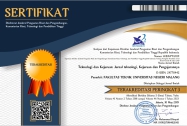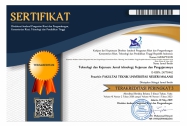The Obstacles and Challenges of Women Workers in the Construction Industry
Abstract
Construction is an industry that contains activities to create or build facilities and infrastructure in a tangible form in order to achieve certain goals. It is known as a male-dominated industry with heavy work, which creates gaps and problems for the women who work there. The purpose of this study is to provide an overview of the obstacles and challenges of women when working in the construction industry. This study uses a qualitative approach with a literature review method. Article searches are performed through the Publish or Perish application on the Scholar platform. After screening through inclusion and exclusion criteria, there were 25 scientific articles from 9 international journals that met the criteria. The result is that the obstacles and challenges faced by women in the construction industry are classified into internal and external. Internal obstacles in the form of: mental readiness, lack of competence, not having a certificate of expertise in a particular field; while the external obstacles are: discrimination based on gender, sexual harassment, lack of organizational support, and disparity in workers' wages. Internal challenges in the form of: self-efficacy, openness, fatigue and work stress; while the external challenges are: high work pressure, long working hours, heavy workload, and masculine culture. To overcome these problems, it requires not only the efforts of each individual, but also the cooperation of all parties involved, especially policy makers in companies and government.
Keywords
Full Text:
PDFReferences
Aneke, E. O., Derera, E. & Bomani, M. (2017). An Exploratory Study of Challenges Faced by Women Entrepreneurs in The Construction Industry In South Africa. International Journal of Business and Management Studies, 9(2), 35-51. Retrieved from https://dergipark.org.tr/en/pub/ijbms/issue/36089/405218
Arditi, D., Gluch, P., & Holmdahl, M. (2013). Managerial competencies of female and male managers in the Swedish construction industry. Construction Management and Economics, 31(9), 979–990. doi: https://doi.org/10.1080/01446193.2013.828845
Barreto, U., Pellicer, E., Carrión, A., & Torres-Machí, C. (2017). Barriers to the professional development of qualified women in the Peruvian construction industry. Journal of professional issues in engineering education and practice, 143(4), 05017002. Retreived from https://ascelibrary.org/doi/abs/10.1061/(ASCE)EI.1943-5541.0000331
Bigelow, B. F., Bilbo, D., Mathew, M., Ritter, L., & Elliott, J. W. (2015). Identifying the Most Effective Factors in Attracting Female Undergraduate Students to Construction Management. International Journal of Construction Education and Research, 11(3), 179–195. doi: https://doi.org/10.1080/15578771.2014.1002639
Bigelow, B. F., Bilbo, D., Ritter, L., Mathew, M., & Elliott, J. W. (2016). An Evaluation of Factors for Retaining Female Students in Construction Management Programs. International Journal of Construction Education and Research, 12(1), 18–36. doi: https://doi.org/10.1080/15578771.2015.1085927
Bowen, P., Edwards, P., Lingard, H., & Cattell, K. (2014). Occupational stress and job demand, control and support factors among construction project consultants. International Journal of Project Management, 32(7), 1273–1284. doi: https://doi.org/10.1016/j.ijproman.2014.01.008
Choudhury, T. (2013). Experiences of women as workers: a study of construction workers in Bangladesh. Construction Management and Economics, 31(8), 883–898. doi: https://doi.org/10.1080/01446193.2012.756143
Dainty, A. R., & Lingard, H. (2006). Indirect Discrimination in Construction Organizations and the Impact on Women’s Careers. Journal of Management in Engineering, 22(3), 108–118. doi: https://doi.org/10.1061/(asce)0742-597x(2006)22:3(108)
Elliott, J. W., Thevenin, M. K., & Lopez del Puerto, C. (2016). Role of Gender and Industry Experience in Construction Management Student Self-efficacy, Motivation, and Planned Behavior. International Journal of Construction Education and Research, 12(1), 3–17. doi: https://doi.org/10.1080/15578771.2015.1016137
English, J., & Bowen, P. (2012). Overcoming potential risks to females employed in the South African construction industry. International Journal of Construction Management, 12(1), 37–49. doi: https://doi.org/10.1080/15623599.2012.10773183
Escamilla, E., Ostadalimakhmalbaf, M., & Bigelow, B. F. (2016). Factors Impacting Hispanic High School Students and How to Best Reach Them for the Careers in the Construction Industry. International Journal of Construction Education and Research, 12(2), 82–98. doi: https://doi.org/10.1080/15578771.2015.1077296
Francis, V. (2017). What influences professional women’s career advancement in construction? Construction Management and Economics, 35(5), 254–275. doi: https://doi.org/10.1080/01446193.2016.1277026
Francis, V., & Prosser, A. (2014). Exploring Vocational Guidance and Gender in Construction. International Journal of Construction Education and Research, 10(1), 39–57. doi: https://doi.org/10.1080/15578771.2012.744371
Jaafar, M., & Othman, N. L. (2013). Assessing the capability of women construction project managers based on liberal feminist theory. International Journal of Construction Management, 13(4), 35–52. doi: https://doi.org/10.1080/15623599.2013.10878228
Jenkins, S., Bamberry, L., Bridges, D., & Krivokapic-Skoko, B. (2018). Skills for women tradies in regional Australia: a global future. International Journal of Training Research, 16(3), 278–285. doi: https://doi.org/10.1080/14480220.2018.1576329
Kaewsri, N., & Tongthong, T. (2014). Favorable Female Attributes in Relation to Career Challenges of Women Engineers in the Thai Construction Industry. International Journal of Construction Education and Research, 10(3), 222–236. doi: https://doi.org/10.1080/15578771.2013.856825
Lekchiri, S., & Kamm, J. D. (2020). Navigating barriers faced by women in leadership positions in the US construction industry: a retrospective on women’s continued struggle in a male-dominated industry. European Journal of Training and Development, 44(6/7), 575-594. doi: https://doi.org/10.1108/EJTD-11-2019-0186
Lu, S. L., & Sexton, M. (2010). Career journeys and turning points of senior female managers in small construction firms. Construction Management and Economics, 28(2), 125–139. doi: https://doi.org/10.1080/01446190903280450
Menches, C. L., & Abraham, D. M. (2007). Women in Construction—Tapping the Untapped Resource to Meet Future Demands. Journal of Construction Engineering and Management, 133(9), 701–707. doi: https://doi.org/10.1061/(asce)0733-9364(2007)133:9(701)
Morello, A., Issa, R. R. A., & Franz, B. (2018). Exploratory Study of Recruitment and Retention of Women in the Construction Industry. Journal of Professional Issues in Engineering Education and Practice, 144(2), 1–10. doi: https://doi.org/10.1061/(ASCE)EI.1943-5541.0000359
Naoum, S. G., Harris, J., Rizzuto, J., & Egbu, C. (2020). Gender in the Construction Industry: Literature Review and Comparative Survey of Men’s and Women’s Perceptions in UK Construction Consultancies. Journal of Management in Engineering, 36(2), 04019042. doi: https://doi.org/10.1061/(asce)me.1943-5479.0000731
Oladotun, A. J., & Edosa, O. M. (2016). The Needs for Professionalism and Competency in the Construction Industry. International Journal of Built Environment and Sustainability, 3(3), 1275–1278. doi: https://doi.org/10.11113/ijbes.v3.n3.142
Rasheed, E. O., Yu, J., Hale, S., & Booth, N. (2022). The Impact of External and Internal Sources of Motivation on Young Women’s Interest in Construction-Related Careers: An Exploratory Study. International Journal of Construction Education and Research, 18(2), 159–178. doi: https://doi.org/10.1080/15578771.2020.1826610
Regis, M. F., Alberte, E. P. V., dos Santos Lima, D., & Freitas, R. L. S. (2019). Women in construction: shortcomings, difficulties, and good practices. Engineering, Construction and Architectural Management, 26(11), 2535-2549. doi: https://doi.org/10.1108/ECAM-09-2018-0425
Samuel, O. B. (2015). The Effects of Organisational Culture and Stress on Organisational Employee Commitment. Management, 5(3), 96–106. doi: https://doi.org/10.5923/j.mm.20150503.03
Styhre, A. (2011). The overworked site manager: Gendered ideologies in the construction industry. Construction Management and Economics, 29(9), 943–955. doi: https://doi.org/10.1080/01446193.2011.588955
Sunindijo, R. Y., & Kamardeen, I. (2017). Work Stress Is a Threat to Gender Diversity in the Construction Industry. Journal of Construction Engineering and Management, 143(10), 04017073. doi: https://doi.org/10.1061/(asce)co.1943-7862.0001387
Tijani, B., Osei-Kyei, R., & Feng, Y. (2020). A review of work-life balance in the construction industry. International Journal of Construction Management, 0(0), 1–16. doi: https://doi.org/10.1080/15623599.2020.1819582
Wagner, H., Kim, A. J., & Gordon, L. (2013). Relationship between Personal Protective Equipment, Self-Efficacy, and Job Satisfaction of Women in the Building Trades. Journal of Construction Engineering and Management, 139(10), 04013005. doi: https://doi.org/10.1061/(asce)co.1943-7862.0000739
Wright, T. (2013). Uncovering sexuality and gender: an intersectional examination of women’s experience in UK construction. Construction Management and Economics, 31(8), 832–844. Doi: https://doi.org/10.1080/01446193.2013.794297
DOI: http://dx.doi.org/10.17977/um031v45i22022p161-167
Refbacks
- There are currently no refbacks.
Copyright (c) 2023 Teknologi dan Kejuruan: Jurnal Teknologi, Kejuruan, dan Pengajarannya
Teknologi dan Kejuruan: Jurnal Teknologi, Kejuruan, dan Pengajarannya
E-ISSN 2477-0442 (online)
Contact
Faculty of Engineering, Universitas Negeri Malang (UM)
Jl. Semarang No 5 Malang 65145, Building H5, 1st Floor.
Homepage: http://journal2.um.ac.id/index.php/teknologi-kejuruan
Email: teknologikejuruan.ft@um.ac.id

This work is licensed under a Creative Commons Attribution 4.0 International License.



2.png)
1.png)
1.png)
1.png)
4.png)
1.png)
.png)

3.png)
1.png)
1.png)


